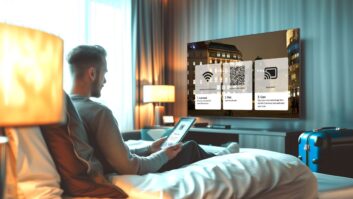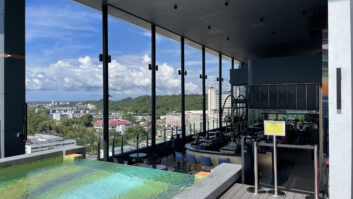Whether working on a new build hotel, or a renovation, in room entertainment options should be studied at the earliest stages of planning. Pierre Lestage, CEO of Locatel, advises interior architects to consider ten key points in the conception of their audiovisual systems, to ensure optimum performance and design integration. 1. The target profile of hotel guestsThe profile of hotel guests impacts the types and levels of services required. Frequent travellers expect to find certain standards wherever they stay. That means when they turn on the TV, they want to enjoy the same media they consume in their home country, whether it be TV channels, radio stations or newspapers. Moreover, they want to be able to find these contents easily and intuitively, rather than navigating through 200 channels to get to the ones that interest them. All travellers need to be provided with advice on points of interest near the hotel, such as transportation and tourism information, as well as on the facilities that the hotel itself has to offer. However the leisure client may also have quite specific entertainment needs, such as children’s TV content with their own language options. Business travellers will also expect access to the internet, as well as practical and up-to-date information on airports, restaurants and business centres, including the hotel’s own restaurant and meeting facilities. 2. The type of internal cabling networkThe installation of TV cabling can be a major expense. However, it is less costly to carry out this work in co-ordination with the fitting of other networks, such as electrical wiring, rather than as an afterthought after construction. Ideally the cabling system should be able to cope with demands on bandwidth as they evolve, so an IP network is normally the best solution. Most hotel IT services are now deployed using IP over structured cabling to allow not only entertainment services but also room controls such as lighting, heating and door key control. The services are delivered to the guest, staff, or operator over one single converged network. However for some hotels, the upgrading of an existing coaxial cable network is not an option. The good news is that the latest systems on the market, such as Eclipse MiRA, mean that a much wider range of interactive services can now be offered on these older networks than would have been previously possible. 3. Who will manage the systemIt is essential that onscreen information, such as online concierge services and conference booking facilities, is kept continually up to date. If designated in-house personnel are managing content, they should be trained and motivated to keep the information fresh, in order for the hotel to derive maximum benefits. A concierge, for example, has every reason to feed content into the system. By doing so he will free up more time for himself, by proactively answering many of the guests’ most frequently asked questions. In-house marketing teams are also a good choice for this task, as communicating directly to the clients on the hotel’s services and special promotions will help them to drive revenues. An alternative solution is to put the entertainment system supplier in charge of managing and updating onscreen information. A good supplier will be able to gather data about services around the hotel through the partnerships they have with various information websites.@page_break@
4. Revenue drivers to make the system self-financingThe latest infotainment systems bring new ways to drive revenue streams. These include the possibility to promote hotel services, thus boosting additional spending per guest night. Earnings can also be generated via on screen advertising and promotions for third party companies. Blockbuster films and adult movies are excellent revenue generators. By offering a rich variety of on-demand options, appealing ways of promoting these options (such as film trailers) and by making it easy to view and access these contents, we have seen hotels achieving up to 80 euros a month per occupied room in additional revenues. Eco-compatible cost savings can be factored in too, as printed promotional materials, such as room service menus and services guides, become obsolete. 5. Cost to be envisagedEntertainment systems can be acquired on either a purchase or lease basis. Whatever option is chosen, there will be a monthly fee for maintenance and for the provision of rights of use for contents. 6. Ensuring quality of serviceAs with most technical equipment, ensuring quality of service means selecting a high quality system. By selecting one with remote management monitoring, most technical issues can be resolved rapidly, without onsite intervention. Different types of maintenance contracts are possible, depending on the type of user interface and rapidity of intervention needed. Another good way of ensuring quality is to install a second, or redundancy, server to ensure service continuity. 7. Envisaging additional features over the longer term The convergence of technical solutions and devices is a certainty. Travellers already have the opportunity to navigate and consult services and contents through their mobile devices. This mobile content will become more plentiful and customised as hotels seek to encourage customer loyalty. The system chosen needs to offer the flexibility and readiness for such developments, and any other future services that may be added.@page_break@
8. Managing film and other content distribution rights It can be very difficult to obtain rights to films, music and TV channels, even for hotels that belong to a large network. Moreover copyright status and legislation in hospitality is very different from the consumer market. Rights should ideally be managed by a supplier, such as Locatel, which benefits from competitively-priced contracts with the major international film distributors, TV and radio stations. 9. Who to consult for adviceA professional integrator with expertise in entertainment systems should be able to offer a product catalogue with a wide choice and propose solutions that will best complement the overall room design. The most practical approach is to use a single technical partner who can provide all the components of system and cover all the multimedia entertainment needs. 10. Infotainment solutions should be selected at the earliest stages of designFor travellers, room design is often a key factor when choosing a hotel. Audiovisual systems should ideally be in harmony with this design. For the most visually pleasing results with the lowest costs, interior architects should plan this aspect at the earliest stages. In this way, requirements for cable installations can be carried out with minimum disruption, and set top boxes and speakers can be fitted into walls or false ceilings. TV screens can be designed to fit into furniture or even behind mirrors. In fact there are now many ways of integrating the entire audiovisual system completely into the room, but architects leave themselves many more possibilities if they consider the above points in their initial planning phases. www.locatel.net
Top ten things to consider when deploying hotel room entertainment systems
Pierre Lestage, CEO of Locatel, advises interior architects to consider ten key points in the conception of their audiovisual systems, to ensure optimum performance and design integration.







